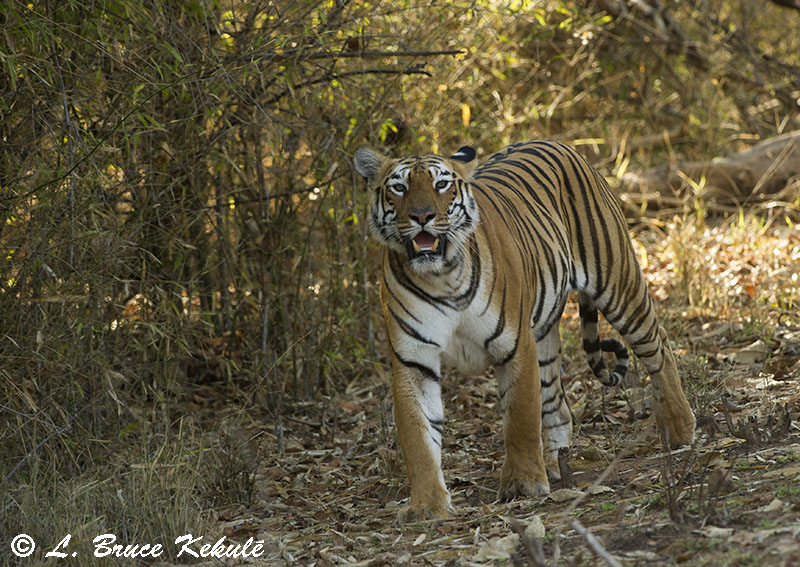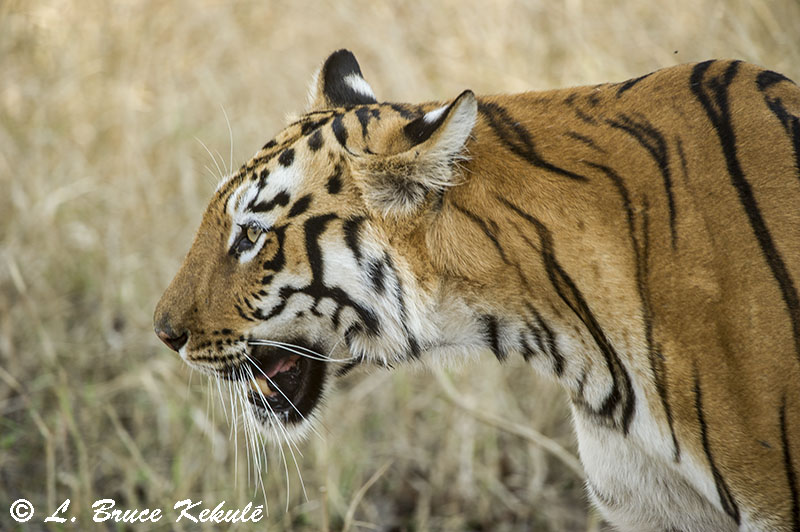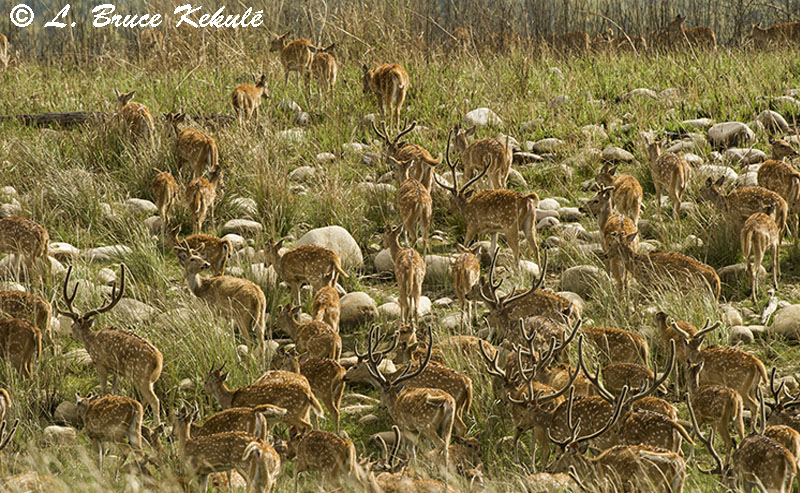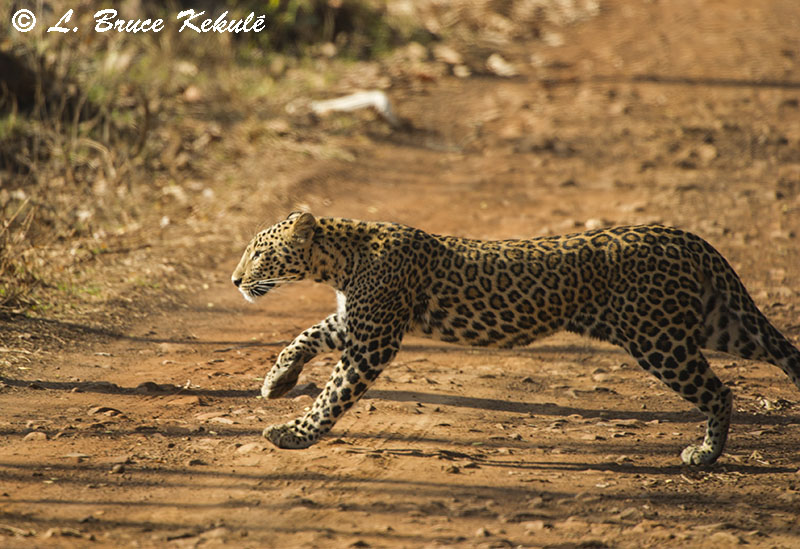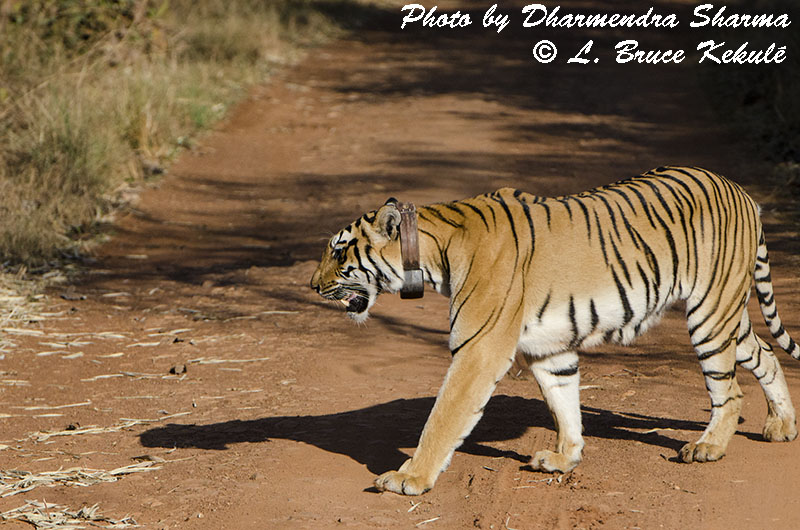Posts Tagged ‘Tadoba Anhari National Park’
India’s ‘Big Six’: Majestic creatures thriving on the sub-continent…!
A photographic tour in three national parks with some pretty amazing animals
A tigress on the run in the grassland at Dhikala, Corbett National Park in the northern State of Uttarakhand.
In 2014, I made a decision to visit India once again in search of the most iconic species still thriving in three protected areas in the northeast, central and northern parts of the country. Kaziranga, Tadoba and Corbett national parks and tiger reserves respectively, were chosen for their wildlife biodiversity with the tiger at the top of the list. I visited the three from February 22 through March 16, 2015.
A mature bull elephant with some impressive ivory in Kaziranga National Park.
I wanted to photograph the big six: elephant, rhino, gaur, wild water buffalo, leopard and the tiger. I was extremely lucky encountering all of these amazing animals during this trip. This has definitely left a huge impression on me and is etched in memory. India’s wildlife and protected areas are some of the best places in the world to see Mother Nature’s wonderful creatures.
Male One Horned Indian rhino 10 minutes from the front gate on my first day in Kaziranga National Park.
A century ago, India was teeming with wildlife. There were some 40,000 tigers found here but that number quickly dropped primarily due to habitat loss after World War II when the population really began to surge and forest areas were overcome, and turned into agriculture fields and estates. Hunting on a grand scale was also responsible for the disappearance of the tiger.
Wild water buffalo cow in Kaziranga National Park.
In 2011, there were only about 1,706 tigers left but in 2014 after better methodology and camera trapping, that number increased to 2,226 individuals found throughout the continent. As a result of mass awareness and conservation measures, the tiger population has rebounded showing a remarkable growth of 30% in the past three years. But some scientists believe this number to be inflated and put the amount of tigers around the 2,000 mark.
A bull gaur with an extremely long tongue in Tadoba National Park.
On 22nd of February 2015, I boarded Air India for the 4-hour flight from Bangkok to New Delhi arriving at noon. After a quick hair-raising taxi ride through the city, I got to the hotel spending one night to rest-up in order to catch the next morning’s flight to Gauhati, the largest city in the State of Assam in northeast India. The hustle and bustle through the domestic airport in Delhi is very tight on security as it should be. But once through the x-ray machines, a bit of a breather and a coffee is welcome. You must get there at least three hours early because of the amount of flights leaving, and the thousands of people trying to catch their respective connections.
A female leopard during late morning in Tadoba National Park.
Kaziranga National Park: State of Assam
A young bull elephant in Kaziranga National Park.
I wanted to visit Kaziranga National Park with the objective of finding out why this place is the number one protected area in the world, and my top priority was the Great Indian one-horned rhino, and then on my list was the wild water buffalo, elephant and tiger in that order. I got the big three but the tiger remained elusive.
A water buffalo photographed by my friend Polash Borah.
My newly acquired friends, Polash Borah and Mohammed Nekib Ali, my naturalist and driver respectively were a big help in locating these large mammals. I let Polash use my Nikon D7000 with a brand new Nikon 70-200mm VRII lens, and he got a really nice buffalo shot posted here. I also managed to get some good photographs myself. It was a great trip and I met some very nice people.
A young one-horned rhino up-close. He was a curious fellow wanting to know who we were.
I will be going back to Kaziranga maybe in November of this year when the skies are clear blue and the air is crisp wanting to get some nice scenic shots especially of the wide Brahmaputra River that runs through the park from the Himalayas in the background, and the lush swamps and grasslands after the monsoon rains.
A mature wild water buffalo bull near a waterway in Kaziranga National Park.
Probably the most important fact concerning Kaziranga is that some 80 years ago, there were about 12 rhinos left here. The Government of Assam decided to do something and implemented some serious laws with a ‘shoot-to-kill’ policy on all poachers and illegal squatters, plus an increase of several hundred personnel. At last count, there are 700 rangers and 161 ranger stations to look after a small 430 square kilometer core area, and a 400 square kilometer buffer zone. After a census last year, there are over 2,400 rhino, 1,500 wild water buffalo and 1,200 elephant. Over 120 tiger have been recorded here and prey species also number in the thousands. In my opinion, it is probably the best-protected area in the world…!
Tadoba National Park: State of Maharashtra
A tiger named ‘Maya’ in Tadoba National Park; she is the most famous tigress seen almost everyday.
After four days in Assam, I flew back to New Delhi for a two-day rest and then boarded a flight on March 3 in the morning down to Nagpur further south. Then a two-hour taxi ride was needed to Tadoba National Park and tiger reserve in the State of Maharashtra. Arriving at the lodge in mid-afternoon, a needed rest and some lunch was in order. I did not go out on safari that afternoon because the park is closed on this day.
‘Maya’ up-close as she walked the road marking her territory.
The next morning’s safari netted a beautiful female leopard highlighted by some wonderful back-light. My spirits were up a hundred percent after photographing the spotted cat.
Female leopard jumping in front of our jeep.
Female leopard up-close as she checks her surroundings.
The next morning as we were rolling around the dusty roads, we bumped into a big crowd of jeeps but they were at the far-end of a one-way road. We waited and saw a tiger walk out of the forest near the jeeps but melted back in. The group then moved close to us but the tiger stayed in the forest. My driver Lahu from the Tiger Trails Lodge has been driving for the owner of the lodge for some 35 years, and knew exactly where the big cat would come out. And as sure as the sun comes up everyday, she popped out and walked right in front of us.
‘Maya’, the female tiger queen in Tadoba National Park: This was my last sighting of this beautiful cat.
I did not stop shooting as Maya, (probably the most popular tigress in Tadoba at the moment) walked along the road spraying and marking her territory. My new friend Dr Sundran Rajendra was with me, and the both of us were so elated that we just kept on shooting our cameras. Then time was up and we had to leave the beautiful cat to herself. It was Sundran’s first tiger and he managed to get some very nice shots of the big cat. She came so close I could almost touch her.
Another tigress, named ‘Choti Tara’ fitted with a radio collar snarls at my friend Dharmendra Sharma.
My other friend and naturalist with the lodge Dharmendra Sharma, was in another jeep so I let him use my Nikon D7000 and the new Nikon 70-200mm VR II, and he got some very nice photos of another female named ‘Choti Tara’ fitted with a radio collar. He also got a few nice shots of Maya.
Male tiger named ‘Gabbar’ fitted with a ‘radio collar’ in pretty bad shape.
On my last afternoon safari in Tadoba, I bumped into ‘Gabbar’, a male tiger also fitted with a collar. He got swatted by another male and was in pretty bad shape. But the wheels are in motion to fix him up. I just hope that the squeaky Indian bureaucracy does not wait too long to help this tiger, as he could turn into a cattle killer or even worse, a man-eater. Needless to say, news on Facebook is that he did kill a village buffalo but is OK for the moment, and is being monitored. After four days, I was back on the plane to New Delhi for a two-day rest before heading north to India’s first national park.
Corbett National Park: State of Uttarakhand
A young tigress stalking a herd of spotted deer in the grassland of Corbett National Park.
It takes about four to five hours north of Delhi by taxi through some very congested and dangerous traffic in the State of Uttar Pradesh to get to Ramnagar, a city in the State of Uttarakhand where Corbett National Park, India’s first national Park. It is situated in the foothills of the great Himalayas. I spent the first night at the Forest Department’s lodge at Bijrani, and went on safari that afternoon and then again the next morning.
A golden jackal on the run near the Forest Department’s lodge at Bijrani.
I did not see a tiger but the big cats were around as other jeeps that I bumped into got some nice close-up photos taken with an iPhone. An occupant in one of the vehicles gave me a telephone slide show. I did see a pair of golden jackals early in the morning and then later a small family unit of elephants. One old cow did a mock charge and came within 15 meters but stopped short and turned around going back to her calf. The elephants then faded off into the forest.
Elephants near the Forest Department lodge at Bijrani.
Around 12-noon, we left this section and went over to the Forest Lodge at Dhikala that is the best site in Corbett to see tigers. Near the lodge, there is a grassland savannah that attracts herbivores like spotted deer in great numbers, and of course many tigers come looking for prey. It is said the park has some 200 tigers, one of the highest densities in India.
A herd of more than 100 spotted deer; the prime food source for tigers in Corbett National Park.
On the second morning, we bumped into a young hunting tigress stalking a herd of over a hundred deer. Me, my naturalist Devendra Singh Neui and my driver Rasheed Ali, were the only ones at this location as all the other jeeps from the lodge (about 10 of them) were waiting for tigers by the forest road. She tried several times unsuccessfully to chase down a deer but the herbivores were on to her. I managed to get some really great images in the process.
The tigress on the run after spotted deer not far from the Forest Department’s lodge at Dhikala.
Later in the afternoon, the camp was abuzz with the news that a tiger was in the lower grassland, and after lunch, they all headed that way and waited nearby. When she appeared, the group went wild chasing after her but they all came up short. We hung back and this very smart tiger circled around to avoid them. I saw her one more time slinking in the grass as the light was fading but time was up as I snapped a few last frames. I had a great time here and have vowed to return to this remarkable place…!
The unlucky tiger chasers in the grassland of Dhikala, Corbett National Park.
The trip to Corbett was scheduled on very short notice by my agents Anu Marwah in New Delhi, and Jason Fernandes in Mumbai both wildlife photographers of great standing in India. They are joint owners of Wilderness Uncut (wildernessuncut.com), a company set-up to cater to wildlife photographers, naturalists and bird watchers. Their superb management and arrangements are first class with absolutely no hiccups and they are reasonable priced. It was a great, enjoyable and memorable trip for me. I can honestly say that I need look no further for anyone to help me with any of my up-coming trips to India.
The female tiger in the grassland of Corbett: this was my last sighting of this beautiful tigress.
One point that I must make here! You never get tired of seeing the world’s biggest cat and is one of the greatest predators that ever walked the face of the Earth. My thoughts are always with these felines and their future survival. Unfortunately, the future for the tiger looks dim, as the situation concerning the Asian medicine trade using their bones seems to be getting worse with more and more stories on the net and in the papers about this draconian belief. The biggest culprits are China, Vietnam, Laos and Thailand (Chinese in Thailand) that perpetuate this market. The tiger needs the whole world to stand up to these people and this illicit trade must be stamped out soon but it carries on with impunity. Until action is taken with economic sanctions and other means against the countries involved, this illegal black-market will continue to take the wild tiger into the dark depths of extinction.
A rare Asian leopard sighting…!
The big cat makes a surprise appearance in India
In 2013, I visited Tadoba Tiger Reserve and national park in the State of Maharashtra, Central India, and spent nine days chasing after tigers with my good friend Luke Stokes from England but who also lives in Thailand like me. We saw seven tigers in nine days that was just awesome for our first trip to the ‘Land of the Tiger’. But the leopard stayed elusive and we did not even get a glimpse of the smaller big cat.
Female posing for me very close to the road – my favorite shot…!
Last year I decided to return to Tadoba once more in March 2015 but had to make bookings way in advance to guarantee a slot. Plans were drawn up, the lodge was selected, dates were locked in and fees were sent. Unfortunately Luke was not able to make this trip with me due to other commitments so I had to go it alone this time. But after a trip to two other Indian tiger reserves in November 2014, I have now become familiar with travel in India that is hectic but has now become almost second nature learning the ropes and system of chaotic India.
Jumping across the road in front of us…!
The flight from New Delhi to Nagpur (the closest city to Tadoba) further south takes about one and half hours and is pretty straightforward. The crowds and security at the airport are tight in Delhi with loads of flights leaving first thing in the morning. I arrived safe and sound to a waiting taxi for the three-hour drive southwest to the lodge just outside the park gate about noon. After some lunch, I rested up and got my cameras ready for the next morning’s safari first thing at 6am.
She is winking at us…!
After a quick coffee and some toast, I jumped into the jeep with a driver and a new acquired friend named Sundran Rajendra, an Indian guy born in Malaysia, brought up in Australia, and now from London. We become immediate friends so at least I had a companion. This was his first trip to India but he was a season traveler having been to Africa many times. We arrived at the gate in five minutes and after paying a small fee for our cameras, moved into the protected area in the dark with a forest guard in tow. The sun began to rise and light filled the forest as we spotted deer and peafowl and other birds just waking up. I was all pumped up but the morning dragged on a bit as we plugged along.
Got her eyes on us now…!
All of a sudden, a leopard was sighted disappearing into the bush. At first I thought that would be it but the driver has worked here for some 35 years and knew what to do. He skillfully moved along the road and stopped ahead of where the leopard might appear. And as sure as the day is long, she moved out of the forest in front of us, hesitated and then jumped across the road disappearing once again. I took a few shots and then we moved once more but this time near a deer kill the mature female had made earlier that morning. She had been chased off by the arrival of several jeeps.
Her final pose before slinking off into the bush – another favorite…!
Once again the driver moved forward and then we waited once again. And like magic, she appeared a third time right in front of us. I did not stop shooting until she left being spooked by too many jeeps arriving. The light became harsh and we had run out of time as the Forest Department has strict rules that must be followed to avoid being fined. Later that morning when the jeeps and everyone had gone, she came back and took the deer kill into the forest for a meal. Sundran and I cheered and jumped up and down celebrating our luck at a rare sighting of an elusive cat. It certainly made our day…! The next morning, we bumped into a female tiger up-close but that is another story to be posted at a later date…Enjoy…!
‘Gabbar’ – A male tiger in Tadoba Andhari National Park
In 1975, a very famous Indian ‘Bollywood’ film was produced named ‘Sholay’, a Hindi action-adventure film that follows two criminals named Veeru and Jai who were hired by a local policeman to chase after a villain named ‘Gabbar’ in the southern state of Karnataka. This classic award winning film is ranked in the ‘Top 10 Indian Films’ of all time. I have not seen the film but will have a look one day soon..!
“Gabbar’ – male tiger with a ‘radio collar’ and severely injured in a small pond near the main road in the park…!
However, this story is not about a villain, but a beautiful mature male tiger named ‘Gabbar’ (also known as ‘Sherkhan’ or ‘T-7’) in Tadoba Tiger Reserve in the State of Maharashtra. In December 2014, he was tranquilized and then fitted with a radio collar to track his whereabouts and behavior by researchers from the ‘Wildlife Institute of India’.
Recently, ‘Gabber’ got into a fight with another male in the park that was witnessed by many on-lookers and severely injured. I have heard from a reliable source that he was in numerous fights with a bigger male and was swiped across the muzzle after the collar was fitted. It is without doubt that collars on male tigers or leopards hamper and prevent them from proper breeding, and they usually lose out to stronger cats without the heavy tightly fitted collar. It is quite possible that he is unable to hunt large animals now and may not survive into the near future…!
A close-up showing his injuries – what a sad looking sight…!
On my last safari during late afternoon in Tadoba on March 9th-2015, I bumped into ‘Gabbar’ lying in a pool sleeping not more than 100 meters from the main road. I stayed there observing him for more than an hour about 50 meters away. He eventually lifted his head very slowly and sadly looked up at me in the jeep. I was using my Nikon D3s and a 200-400mm VR II attached with a 2X tele-converter to get a close-up shot of him. I was devastated to see the extent of his wounds and it looks like he is very sick with fever probably from infection.
If any of those researchers who are responsible for this tiger read this; you must (should) get in there and re-capture him immediately, and remove the collar and treat his wounds if you have any compassion for wildlife. He looked very sick and may not survive this ordeal. Please do not hesitate, as his death would certainly be on your hands in the name of science. Data gathered by these people is not worth the demises of even one tiger; they are now too rare in the wild for this collaring practice to continue with any real outcome in the field of wildlife conservation, or protection and enforcement of the protected area.
‘Choti Tara’ female on the road in late morning…!
Furthermore, there is another female named ‘Choti Tara’ also fitted with a collar in Tadoba in December 2014. It was observed by some people at the lodge I was staying at that a researcher with an antenna following the female gave pertinent information to some drivers where she was going. A group of some 20 jeeps then rushed off in a cloud of dust to wait for her to reappear at the other side of the forest. This is total madness and certainly will give the researchers and park a bad name, and must be stopped now…!
I feel that the ‘Spirits of the Forest’ let me photograph ‘Gabbar’ to reveal the serious situation he is in. I’m hoping that a concerted effort will be undertaken to save this magnificent cat from bereavement, and maybe I played a small roll in his continued survival. He certainly deserves more respect than what he is getting at the moment, and the trauma he is going through needlessly. To the ‘Wildlife Institute of India’ and the Forest Department of Tadoba: PLEASE ACT NOW BEFORE IT IS TOO LATE..!
Check this tale out: https://www.facebook.com/notes/joydip-kundu/radio-collar-kills-sunderbans-tigress-toi/10153121234347207?pnref=story












